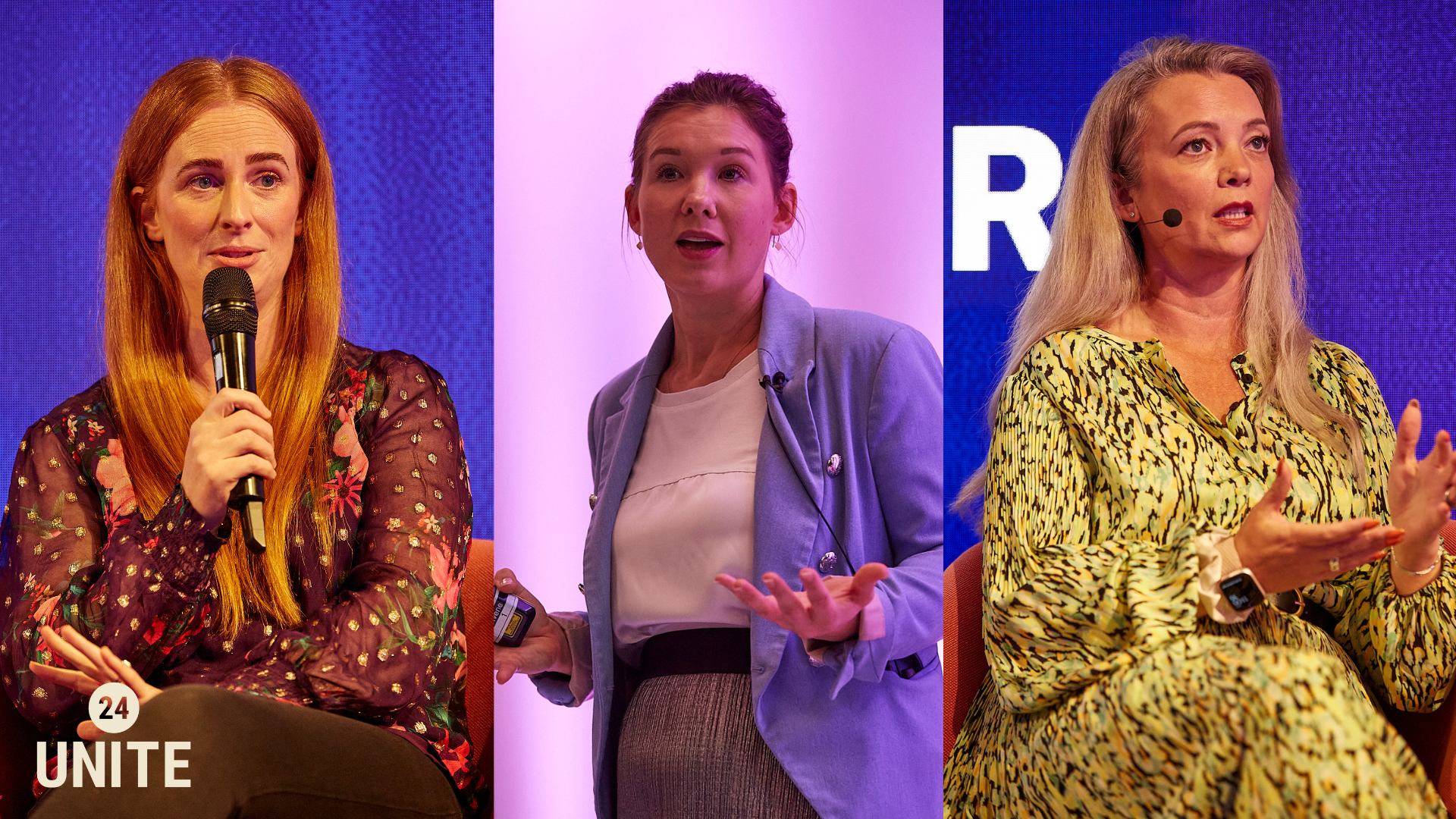
Unite 2024 brought together industry thought leaders to discuss some of the most pressing topics in internal communications (IC) today. Among the debates and insights shared, three main themes stood out: the role of employee marketing in IC, the growing influence of IC leaders within employee experience (EX) superteams, and the evolving importance of social in building engagement.
1. The employee marketing debate: Helpful or hindrance?
The concept of "employee marketing" sparked a lively debate during the Ask an internal comms expert panel, particularly between Jennifer Sproul, CEO of the Institute of Internal Communication (IoIC), and Joanne Frankel, Head of Internal Communications at Amdocs. The session revealed a key question for IC leaders: should IC embrace a marketing-oriented framework, or does it risk compromising the authenticity of internal communications?
Jen’s perspective: Jen emphasized that IC's core mission remains creating an informed, connected, and purposeful workforce. She sees IC’s role as evolving beyond simple information dissemination to advising leadership on effective communication strategies across all touchpoints. Jen argued that "employee marketing" can detract from the authenticity of IC by placing undue focus on transactional messaging rather than fostering real connection and trust. Instead, she suggested that IC should continue focusing on building an environment where employees feel informed, engaged, and aligned with organizational goals.
"Our role is shifting to not just sending out information but sitting in front of leaders and advising them on what to say, how to say it, where to say it, and how to drive those things."
Jennifer Sproul, Chief Executive, The Institute of Internal Communication
Joanne’s perspective: Joanne took a different view, advocating for “employee marketing” as a way to embrace personalization and target specific employee needs. By drawing on marketing strategies, Joanne believes IC can deliver more resonant and impactful messages. For her, "employee marketing" underscores a data-driven, segmented approach that recognizes individual employee preferences, ultimately making IC more strategic and aligned with business goals.
"We need to stop talking about IC as a support function and instead as an IC partner. We should be solving business needs and driving value, not just sending out messages."
Joanne Frankel, Head of Internal Communications, Amdocs
Takeaway for IC leaders: This debate highlights a crossroads for IC leaders. A balanced approach - leveraging data for personalization while remaining true to IC's core values - could allow IC to remain authentic while delivering targeted, impactful communications. IC leaders can take inspiration from both perspectives, positioning themselves as trusted advisors who drive both connection and business alignment.
2. IC’s growing role within the EX Superteam
Another major theme at Unite 2024 was the increasing influence of IC professionals within employee experience (EX) superteams. With three out of four EX team members at many organizations now coming from an IC background, IC’s role is expanding from support to strategic leadership. Both Jen and Joanne highlighted that IC leaders are no longer just the "messengers" but now drive performance by aligning communications with business needs and advising leaders on messaging strategies.
Changing Roles of Internal Communicators: The panel emphasized that IC is shifting from traditional “housekeeping” roles to adding real value by influencing business strategy. IC leaders today are expected to drive organizational performance and actively contribute to business goals by fostering engagement and ensuring that communication aligns with the company’s mission. As Jen put it, “We’re not just sending messages; we’re shaping conversations that matter.”
In our deep dive session on “Surprising insights from the largest internal comms data set,” Sharn Kleiss, Employee Experience Strategy Lead and Chris Andrew, Communication Consulting Lead at Gallagher shared statistic from Gallagher’s State of the Sector Report. Sharn shared that “82% of respondents said that supporting culture and belonging is the primary purpose of internal communications” and that “74% of communicators measure employee engagement as a key success indicator, yet disengaged employees remain the second-biggest barrier to achieving success”.
Leveraging AI in IC: Both speakers acknowledged that AI and automation are reshaping IC, making it possible to streamline content creation, campaign planning, and audience analysis.
Joanne states: “I've understood that as communicators we have the superpower because the platform [GPT] you don't need to know coding you don't need to be a techie but you do need to know how to communicate. And the better you interact with AI the better it works for you. So, I hope by next year we will be for a lot of the repetitive tasks like creating all kinds of content assets and campaign planning we will be using GPTs that we've created for ourselves”.
During our Executive insights: The future of employee experience panel, Zaynab Zubair, Digital People Experience Lead at EY shared: "The hype cycle around AI will start to wane, and comms and change professionals need to keep the momentum going through the trough of disillusionment”.
Action for IC Leaders: To capitalize on this shift, IC leaders should actively engage with HR, IT, and operations to create a well-rounded EX strategy. By positioning themselves as trusted advisors who understand employee needs and communication best practices, IC leaders can ensure that employee experience initiatives resonate with and empower the workforce. This shift from a support function to a strategic role enables IC leaders to have a more profound impact on employee engagement and organizational success.
3. The power of social in building engagement and connection
As the sun sets on social platforms like Workplace by Meta, and companies re-evaluate their social strategy, the challenge remains the same: How do you build a meaningful, engaged community across a diverse and global workforce? For companies like Alshaya who operate 70 world-class brands, including Charlotte Tilbury, Disney, Starbucks, H&M, and Chipotle, across 17 countries, the key to better social lies in content.
Laura Jamieson, Head of Internal Communications at Alshaya Group, shared tangible examples of how investing in social media led to a rise in customer satisfaction scores from 78% to 85%. Laura emphasized that social media isn’t just about disseminating information but about fostering real connections across departments, roles, and locations.
Engaging Frontline Employees: The challenge of engaging frontline employees—who may not have regular access to digital tools—was a recurring theme. Strategies discussed included leveraging line managers as communication champions, personalizing messages, and creating physical touchpoints such as pop-up events or "beauty bars" for sharing updates. These efforts ensure that frontline employees feel connected to the organization’s goals and are equipped with relevant information. Alshaya’s impressive engagement survey results, with a 92% participation rate and 78% engagement score, illustrate how targeted social strategies can resonate powerfully with a diverse workforce.
Social as a Storytelling and Recognition Platform: By positioning social as a platform for storytelling, collaboration, and recognition, IC leaders can create a more dynamic and inclusive communication environment. Employees who feel they can share their contributions and celebrate each other’s successes experience a greater sense of belonging and purpose. Social channels can serve as hubs for collaboration and engagement, amplifying employees' voices and creating a sense of community.
Supporting Organizational Alignment and Culture: Emma Grede, CEO of Good American and SKIMs, emphasized that authentic culture is “how you do things,” not just words on a wall. Social platforms provide a channel for employees to embody and share these values in a way that feels genuine and personal. Jenny Shires, Chief People Office at Unily in the Executive Insights Panel, noted: “I think you have to bring people along with you on the journey… You can't impose a vision and then just expect everyone to fall into line. So, I think it's important to iterate on what the vision is even what your values are what your goals are”. This approach helps IC leaders reinforce a consistent organizational culture while fostering alignment with business goals.
Next Steps for IC Leaders: To leverage social effectively, IC leaders should consider creating employee-driven social channels that amplify stories, celebrate successes, and encourage peer recognition. Working with HR and management, IC leaders can identify key areas where social can support organizational goals, such as improving customer experience, fostering engagement, or reinforcing culture. Tailoring social strategies for frontline employees - such as through mobile accessibility or manager-led communications - ensures that all employees can connect with the organization’s values and mission.
The role of IC Leaders in the future of work
As we move forward, IC leaders are pivotal in shaping how organizations communicate and engage with their employees. By embracing inclusivity, simplifying communication, and leveraging data, you can build a more connected and engaged workforce.
In today’s competitive landscape, prioritizing effective internal communication is essential for driving innovation, productivity, and long-term success. Now is the time for IC leaders to take the lead in cultivating a thriving organizational culture and enhancing the employee experience.
Interested in speaking at Unite 25?
Speaker applications are now open! If you're an Internal Communications leader who's passionate about employee experience transformation, we want to hear from you. Find out more and register your interest here.
Stay in the loop!
Stay up to date on the latest Unite news and be the first to find out when you can watch all sessions on demand. Join the community here.
Get started. Get your personalized demo.

With a keen focus on AI search and community features, Amy supports the creation of solutions tailored for the future of work at Unily. As Product Marketing Manager, she combines her expertise in digital strategy with a passion for guiding large organizations toward enhanced employee experiences. Her insights help shape Unily’s innovative offerings, ensuring they not only meet but also anticipate the complex needs of demanding enterprises.